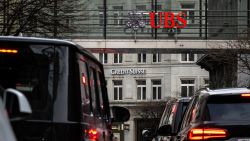After a major, systemically significant bank crumbled over the weekend, the banking crisis left financial institutions and regulators scrambling Monday to prevent its spread.
Credit Suisse, hobbled for decades by mismanagement, scandal and bad bets, finally succumbed to the emerging global banking crisis. Its stunning and rapid takeover by rival UBS, orchestrated by Swiss authorities Sunday, took one giant, wobbling domino off the table. Hours later, a group of central banks from around the world boosted the movement of US dollars through the global financial system to keep loans flowing to households and businesses and support the world’s major economies.
The question investors and nervous customers want answered this week: What’s next? Are other banks about to fall – or be saved? Will regulators be forced to step in with more rescue plans?
In the United States, the banking crisis began nearly two weeks ago with the sudden collapses of Silicon Valley Bank and Signature Bank over a three-day span. That sent shockwaves through the global banking system.
Regional banks with similar profiles to SVB, including First Republic Bank (FRC), PacWest (PACW) and Western Alliance (WAL), have teetered on the brink over the past week. Anxious customers have pulled tens of billions of dollars in cash from the smaller banks and placed them with bigger institutions that are better capitalized.
To pay customers their withdrawals, regional banks have scrambled to access enough cash. First Republic received a $70 billion loan from JPMorgan Chase a week ago and another $30 billion lifeline from a consortium of 11 banks, organized by US regulators, on Thursday. That still appears to be insufficient, with First Republic’s shares tumbling another 33% Friday.
Moody’s downgraded First Republic’s credit rating to junk status Friday night and S&P cut the bank’s rating to junk Sunday. Moody’s said the downgrade reflects the deterioration of the bank’s financial profile and “significant challenges” it faces from its reliance on shorter-term and higher-cost funding as customers yank their cash out.
And many other banks, the identities of which will likely remain unknown for quite some time, sought emergency loans from the Federal Reserve over the past week. Banks borrowed a record $153 billion from the Fed’s discount window last week – a last-resort option for banks to gain quick access to cash.
Good news and bad news
The good news: Those loans do not indicate anything inherently wrong with the global banking system. None of the banks that borrowed from the Fed’s discount window borrowed on secondary credit terms – emergency, overnight loans that help deeply troubled banks keep the lights on. Those loans come with severe restrictions and more oversight from the Fed.
The fact that the loans the Fed delivered were primary credit “indicates that US bank supervisors consider the banks that needed emergency support ‘healthy’ and not at elevated risk of imminent failure,” noted Jill Cetina, Moody’s analyst, in a note to investors Friday.
Global financial regulators agree, using seemingly every opportunity they can get to shout from the mountaintops that the banking system is secure, healthy and flowing with cash.
The bad news: Banks may be healthy on the whole, but all that borrowing shows just how much strain is on the financial system at the moment.
Strain means banks may be resistant to lend money, adding more scrutiny to the creditworthiness of borrowers. That means fewer mortgages and less money flowing to businesses, which could slow the global economy and potentially lead to a recession.
That’s why central banks stepped in on Sunday. Their coordinated action, the likes of which the world hasn’t seen since the European debt crisis a decade ago, represents the first indication that the banking crisis could have long-lasting and damaging effects to the global economy.
How will this end?
The solution would be for customers to stop withdrawing deposits. But the banking system and regulators would have to calm fears before that happens system-wide.
That’s why there are growing calls for US authorities to guarantee all customer deposits, regardless of whether they’re insured or uninsured. The US Federal Deposit Insurance Corporation insures deposits at eligible banks up to $250,000 per account. European countries operate similar programs.
If regulators insured all deposits of all sizes, similar to what happened to Silicon Valley Bank and Signature customers after those banks failed, that could give customers confidence that their money is safe with regional banks.
Moody’s on Friday said there is a “high likelihood” that federal regulators could invoke a systemic risk exception to protect all uninsured depositors at First Republic. But if regulators make an exception for just one more bank, that would mean rescuing every teetering bank.
US authorities may be reluctant to do that if there’s a chance the system can work out its problems on its own. With a looming debt ceiling crisis and intense scrutiny about using taxpayer money to fund anything close to resembling a bailout, the Biden administration would almost certainly prefer an organic solution to the crisis.
There’s some evidence that may be starting to happen.
Western Alliance, which reported a large amount of withdrawals last week, and Charles Schwab, which earlier in the weeksaid average margin balances were down 28% at the end of February compared to February 2022, both sought to reassure customers and investors by saying deposits were relatively steady over the past few days and they remained sufficiently liquid – which means they have enough cash to continue to fund their operations.
And a US official told CNN that deposits at small and midsize American banks have stabilized in recent days, with outflows either slowing, stopping or in some cases reversing.
Credit Suisse’s problems – years in the making – are unrelated to the recent deposit runs at US banks. But after UBS came to the rescue of Credit Suisse, the flood of deposit withdrawals from US regional banks eased and central banks tried to make dollars more available to keep banks lending, there’s hope the current banking crisis fades and the world evades an economic downturn.
What’s certain: This isn’t over yet.
– CNN’s Matt Egan and Phil Mattingly contributed to this report
Clarification: This story has been updated to clarify what Charles Schwab announced in theprevious week.
























